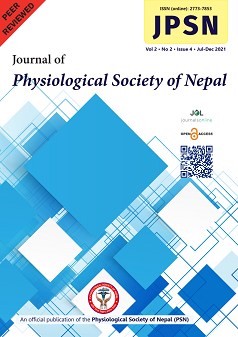Effect of yoga on cardiac autonomic tone and lipid profile in perimenopausal women
DOI:
https://doi.org/10.3126/jpsn.v2i2.50174Keywords:
Perimenopause, heart rate variability, LDL-cholesterol, HDL-cholesterol, yogaAbstract
Introduction: Cardiovascular diseases and cholesterol levels are increased postmenopausal/perimenopausal women. Cardiac autonomic tone as assessed with heart rate variability (HRV) is also altered in postmenopausal women. Yoga practice improves vasomotor symptoms in postmenopausal women. Whether yoga can improve HRV and cholesterol levels in perimenopausal women is not clear.
Methods: Sixty perimenopausal women, not on any medication, were randomized into two groups; yoga (n=30, age 44±2.64 years) and control (n=30, age 46±5.09 years). The yoga group practiced meditation, pranayama, and few simple asanas for 40 min/day, 6 days/week for four weeks along with their daily routine activities. The control group practiced no additional exercises except their daily routine activities. Short-term HRV, lipid profile, and other biochemical parameters were assessed at the beginning and after four weeks and compared.
Results: Both groups were comparable in terms of their age body mass index (BMI), blood pressure (BP), heart rate (HR), and respiratory rate at 0 week. The yoga group showed a decrease in BMI, HR, systolic BP, total cholesterol [167.81±32.69 vs 144.46±26.98 mg/dl, p=0.013], LDL-cholesterol [118.19±28.25 vs 94.33±23.55 mg/dl, 0.002]; and an increase in HDL-cholesterol (49.62±6.34 vs 56.37±8.19 mg/dl, p=0.004), markers of cardiac parasympathetic tone [SDNN {33.3(24.35-40.1) vs 43.2(34.4-50.1) ms, p=0.041}, rMSSD {25.2(21.95-33.05) vs 30.6(25.1-38.0) ms, p=0.034}, and high frequency power] after four weeks of yoga practice.
Conclusion: Parasympathetic tone and HDL-cholesterol increased, whereas total and LDL-cholesterol, BMI, HR, and systolic BP decreased in perimenopausal women after four weeks of yoga practice. It is suggested that yoga can be a cardio-protective alternative therapeutic measure in perimenopausal women.
Downloads
Downloads
Published
How to Cite
Issue
Section
License
Copyright (c) 2021 Journal of Physiological Society of Nepal

This work is licensed under a Creative Commons Attribution-NonCommercial 4.0 International License.

